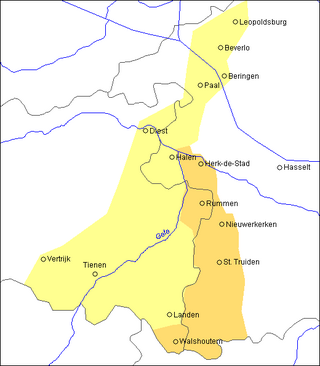Related Research Articles
Middle Dutch is a collective name for a number of closely related West Germanic dialects whose ancestor was Old Dutch. It was spoken and written between 1150 and 1500. Until the advent of Modern Dutch after 1500 or c. 1550, there was no overarching standard language, but all dialects were mutually intelligible. During that period, a rich Medieval Dutch literature developed, which had not yet existed during Old Dutch. The various literary works of the time are often very readable for speakers of Modern Dutch since Dutch is a rather conservative language.

The voiceless uvular fricative is a type of consonantal sound that is used in some spoken languages. The symbol in the International Phonetic Alphabet that represents this sound is ⟨χ⟩, the Greek chi. The sound is represented by ⟨x̣⟩ in Americanist phonetic notation. It is sometimes transcribed with ⟨x⟩ in broad transcription.

Limburgish, also called Limburgan, Limburgian, or Limburgic, is a West Germanic language spoken in the Dutch and Belgian provinces of Limburg and in the neighbouring regions of Germany.
The phonology of Catalan, a Romance language, has a certain degree of dialectal variation. Although there are two standard varieties, one based on Central Eastern dialect and another one based on South-Western or Valencian dialect, this article deals with features of all or most dialects, as well as regional pronunciation differences.
There is significant phonological variation among the various Yiddish dialects. The description that follows is of a modern Standard Yiddish that was devised during the early 20th century and is frequently encountered in pedagogical contexts.
Dutch phonology is similar to that of other West Germanic languages, especially Afrikaans and West Frisian.
In dialectology, Southeast Limburgish, also referred to as Southern Meuse-Rhenish, is one of the subdivisions of a group of Low Franconian varieties also sometimes called Meuse-Rhenish. Both terms denote a rather compact grouping of varieties spoken in the Limburg and Lower Rhineland regions, near the common Dutch/Flemish (Belgium) and Dutch/German borders.
Unlike many languages, Icelandic has only very minor dialectal differences in sounds. The language has both monophthongs and diphthongs, and many consonants can be voiced or unvoiced.
Hard and soft G in Dutch refers to a phonetic phenomenon of the pronunciation of the letters ⟨g⟩ and ⟨ch⟩ and also a major isogloss within that language.
This article covers the phonology of modern Colognian as spoken in the city of Cologne. Varieties spoken outside of Cologne are only briefly covered where appropriate. Historic precedent versions are not considered.
This article aims to describe the phonology and phonetics of central Luxembourgish, which is regarded as the emerging standard.
The phonology of Old Saxon mirrors that of the other ancient Germanic languages, and also, to a lesser extent, that of modern West Germanic languages such as English, Dutch, Frisian, German, and Low German.
This article is about the phonology and phonetics of the West Frisian language.
This article covers the phonology of the Orsmaal-Gussenhoven dialect, a variety of Getelands spoken in Orsmaal-Gussenhoven, a village in the Linter municipality.
Hamont-Achel dialect or Hamont-Achel Limburgish is the city dialect and variant of Limburgish spoken in the Belgian city of Hamont-Achel alongside the Dutch language.
Kerkrade dialect is a Ripuarian dialect spoken in Kerkrade and its surroundings, including Herzogenrath in Germany. It is spoken in all social classes, but the variety spoken by younger people in Kerkrade is somewhat closer to Standard Dutch.
Hasselt dialect or Hasselt Limburgish is the city dialect and variant of Limburgish spoken in the Belgian city of Hasselt alongside the Dutch language. All of its speakers are bilingual with standard Dutch.
Weert dialect or Weert Limburgish is the city dialect and variant of Limburgish spoken in the Dutch city of Weert alongside Standard language. All of its speakers are bilingual with standard Dutch. There are two varieties of the dialect: rural and urban. The latter is called Stadsweerts in Standard Dutch and Stadswieërts in the city dialect. Van der Looij gives the Dutch name buitenijen for the peripheral dialect.

Getelands or West Getelands is a South Brabantian dialect spoken in the eastern part of Flemish Brabant as well as the western part of Limburg in Belgium. It is a transitional dialect between South Brabantian and West Limburgish.
The phonology of the Maastrichtian dialect, especially with regards to vowels is quite extensive due to the dialect's tonal nature.
References
- ↑ Stichting Kirchröadsjer Dieksiejoneer (1997), p. 36.
- ↑ Stichting Kirchröadsjer Dieksiejoneer (1997), pp. 17, 19, 21, 126.
- ↑ Russ (1989), p. 230.
- 1 2 Stichting Kirchröadsjer Dieksiejoneer (1997), p. 18.
- 1 2 Stichting Kirchröadsjer Dieksiejoneer (1997), p. 17.
- ↑ Russ (1989), pp. 228–229.
- ↑ Stichting Kirchröadsjer Dieksiejoneer (1997), pp. 15–17.
- 1 2 3 4 5 Stichting Kirchröadsjer Dieksiejoneer (1997), p. 16.
- ↑ Stichting Kirchröadsjer Dieksiejoneer (1997), pp. 16, 18.
- ↑ Verhoeven (2007), pp. 221, 223.
- ↑ Stichting Kirchröadsjer Dieksiejoneer (1997), pp. 15, 18.
- ↑ Fournier, Rachel; Gussenhoven, Carlos; Peters, Jörg; Swerts, Marc; Verhoeven, Jo. "The tones of Limburg". Archived from the original on 26 February 2012. Retrieved 26 February 2012.
- 1 2 Stichting Kirchröadsjer Dieksiejoneer (1997), p. 19.